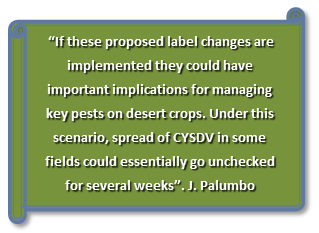
The U.S. Environmental Protection Agency (EPA) recently proposed additional mandatory
pesticide label restrictions that would prohibit the application of acutely toxic
pesticides during the time crops are in bloom and commercial bees have been placed
in or near fields for pollination services. If these proposed label changes are
implemented they could have important implications for managing key pests on desert
crops which require the use of contracted bees for pollination. Specifically, the
proposed labelling reads as follows: “Foliar application of this product is
prohibited from onset of flowering until flowering is complete when bees are on-site
under contract”. This label would apply to pesticides that have an acute contact
toxicity value less than 11 micrograms per bee (LD50<11 μg/bee). Unfortunately
for desert producers, the list of acutely toxic insecticides includes all of the
pyrethroid, organophosphate, carbamate and neonicotinoid insecticide active ingredients
currently used for control of major pests. Also included in this list are Exirel,
Radiant, Success, Sequoia, Abamectin, Proclaim, Avaunt and Torac. Even insecticides
approved for organic production are not exempt, as azadirachtin (e.g., Aza-Direct),
pyethrins (e.g., Pyganic), spinosad (Entrust) and rotenone are also on the restricted
list. The full description of the proposed label changes, including the list of
acutely toxic pesticides (Appendix A) affected and proposed label language (Appendix
B), can be found here:
EPA’s
Proposal to Mitigate Exposure to Bees from Acutely Toxic Pesticide Products.
In my view, fall melons would be most directly affected by this proposed label change.
Economic production of fall melons requires pollination services, but of course
also requires adult whitefly control during the bloom/pollination period to suppress
the spread of virus (CYSDV). Based on EPAs proposed label restrictions, application
of industry standards like Assail, bifenthrin, fenpropathrin, and Exirel would not
be allowed anytime, day or night, on fall melons as long as commercial bee hives
are present. This could make whitefly/CYSDV control during bloom very difficult.
UA research has clearly shown that the remaining alternatives labeled for whitefly
control not on EPAs proposed list (i.e.,
Knack,
Vetica,
Oberon,
Coragen,
Fulfill,
Beleaf) have little effect on preventing
virus infection. Under this scenario, spread of CYSDV in some fields could essentially
go unchecked for several weeks. If you are interested in voicing your opinion on
this new proposal, EPA is currently accepting public comments until July 29, 2015.
For more information on how to submit comments go to:
http://www2.epa.gov/pollinator-protection/proposal-protect-bees-acutely-toxic-pesticides
and
http://www.regulations.gov/#!docketDetail;D=EPA-HQ-OPP-2014-0818.




